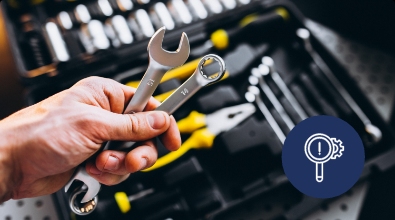

Dehumidifier maintenance: Effective tips for DIY repair.
Constructed for heavy-duty performance under a spectrum of difficult weather conditions and unpredictable terrains without compromising performance, dehumidifier maintenance tips and tricks are a crucial step in ensuring long-term operational effectiveness without any downgrades in performance. Read our blogs to know more about the do-it-yourself maintenance tips for your humidity removal units.
Dehumidifier maintenance in 7 easy steps.
There is no doubt that dehumidification units are sturdy and constructed to deliver exceptional performance without downgrading performance for a consistently longer period of time, serving the primary purpose for which these units are constructed.
Finding use in an extensive array of applications for effective moisture management, these moisture management devices lose their operational efficiency over the period of time, due to their rigorous functioning.
However, just like any other electrical appliance, these humidity removal units require maintenance at distinct intervals to ensure optimal performance and longevity, which would otherwise lead to unit replacement, incurring a costly upfront investment.
Proper maintenance of dehumidifiers is crucial for several reasons. Firstly, it ensures the efficiency of the unit.
Over time, the air filter equipped in the unit is stuffed by dirt particles, contaminants, and impurities from the air, which if not cleaned and addressed, can hinder the operational functions of the unit. By regularly cleaning and maintaining the unit, you can maximize its dehumidification capacity and energy efficiency.
Secondly, dehumidifier maintenance helps to prevent potential issues and costly repairs. Neglecting maintenance can lead to clogged filters, damaged coils, or malfunctioning components.
These problems not only decrease the performance of the unit but can also result in more extensive damage.
By following simple dehumidifier maintenance tips, you can avoid these issues and prolong the lifespan of your dehumidification system, reducing the dependency on completely replacing the unit, which demands a hefty upfront investment.
Clean the air filters: The filters in your dehumidifier help trap airborne particles, such as dust and allergens. Regularly cleaning or replacing these filters is essential to maintain good airflow and prevent debris buildup.
Clean the unit coils: Over time, the coils in your dehumidifier can accumulate dirt and grime, reducing their effectiveness and efficiency. Gently cleaning the coils with a soft brush or cloth can help improve their performance and prevent potential blockages.
Empty and clean water tank: These humidity remover machines collect excess moisture in a water tank or bucket. It's important to regularly empty and clean this tank to prevent the growth of mold or bacteria.
Check drainage system: Some dehumidification system have a built-in drainage system that allows continuous water removal. Ensure that the drainage hoses are clear and free from obstructions. Regularly inspect the system to avoid leaks or blockages.
Leverage professional dehumidifier maintenance: Consider having your dehumidifier serviced by a professional technician annually or as recommended by the manufacturer. They can inspect and address any potential issues that may require specialized attention.
Dehumidifier troubleshooting to fix common issues.
Humidity removal units are an undeniable component from an array of settlements, be it industrial, residential, commercial, or even spaces such as cold rooms, offices, garages, etc.
Like any other electrical machinery, these units are highly efficient in removing surplus moisture from the atmosphere, geared with industry-grade premium components and resilient features.
However, there might be an array of incidents where due to certain internal faults, the unit might hinder its operations, where dehumidifier troubleshooting fixes are critical problems.
Regular dehumidifier fixing is essential for several reasons. Firstly, it helps identify and resolve minor problems before they escalate into major issues, potentially saving you from costly repairs or replacements.
Secondly, troubleshooting can restore your unit’s efficiency, allowing it to function optimally and reduce energy consumption.
Lastly, by resolving problems promptly, you can extend the lifespan of your unit, ensuring it continues to provide reliable moisture control for years to come.
Read our blog wherein you can discover detailed dehumidifier servicing tips that you can counter yourself, and ensure a smooth and efficient unit performance without jeopardizing performance, and without any working disruptions.
Dehumidifier tips and tricks.
There is no doubt in admitting that dehumidification units are an inseparable component from surroundings where maintaining optimal humidity levels are crucial.
After buying a dehumidifier, it is important to know specific tips and tricks to ensure optimal performance of the unit, and you can be rest assured that your vicinity is free from surplus moisture accumulation.
Though humidity removal units serve the primary purpose of removing redundant moisture levels, irrespective of the settlement they are incorporated in, and the robust features they are equipped with.
These dehumidifier tips typically include metrics such as choosing the right dehumidifier, placing the unit at an ideal location for effective dehumidification, setting the right humidity levels, ensuring optimal ventilation, using the unit in conjunction with other appliances, and more.
Read our comprehensive guide on incorporating the best dehumidifier tips to get the most out of your moisture management unit.



